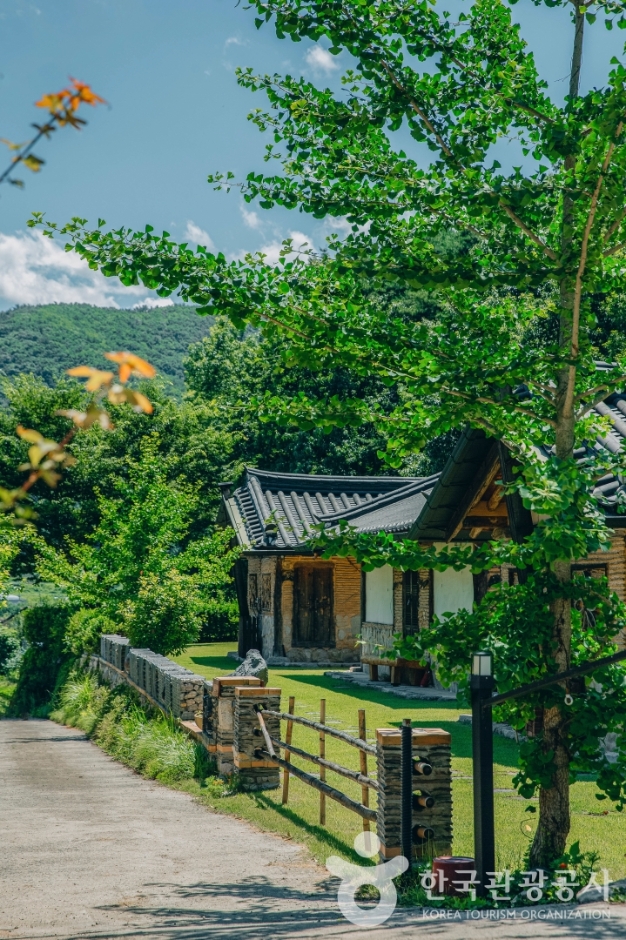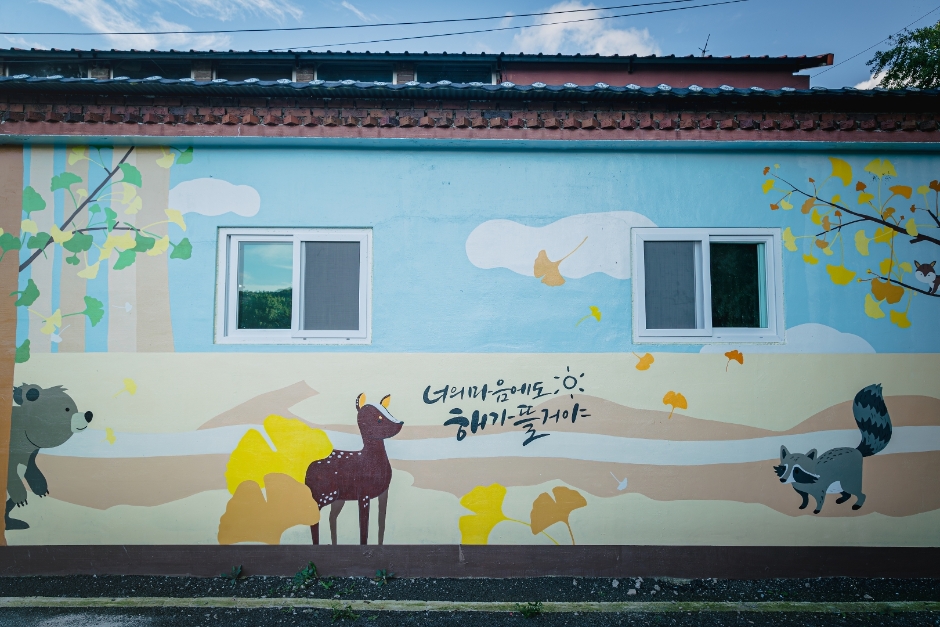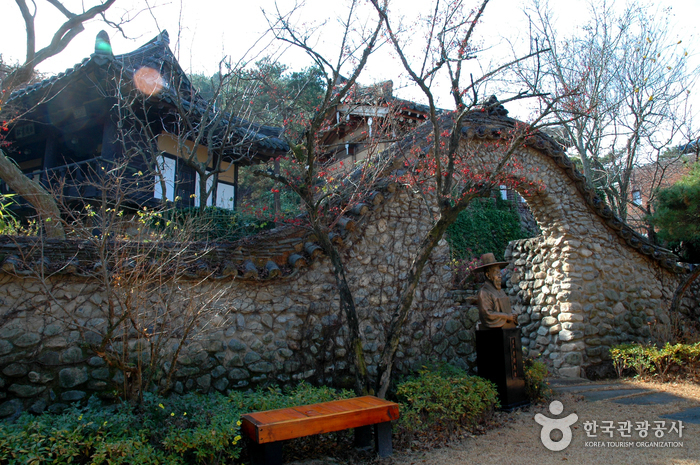Bulguksa Hanok Farm Stay [Korea Quality] / 불국사한옥팜스테이 [한국관광 품질인증]
11.4Km 2022-04-06
5-52, Jinti-gil, Gyeongju-si, Gyeongsangbuk-do
+82-10-5489-1742
Bulguksa Hanok Farm Stay is an accommodation that offers many programs located right below Bulguksa Temple in Jinhyeon-dong, Gyeongju-si, Gyeongsangbuk-do. There is a total of four guest rooms. Every guest room has a bathroom and a kitchen inside. You can also cook in the rooms as they are equipped with cooking appliances such as a rice cooker, microwave, and electric stove. Ouga is a double-story unit, and the guest rooms on the first floor and the second floor are rented separately. On the first floor, there is an ondol room big enough for four people, and the ondol room on the second floor is big enough for three people and has a nice view. Both rooms have a terrace where guests can enjoy a barbecue grill. Bogyeonga also has two guest rooms that are rented separately. All of the rooms are ondol type rooms. In the Bogyeonga building, only room 1 has a double-story structure. Guests staying in the Bogyeonga building can have a barbecue grill in the terrace. A well-maintained garden is surrounding the hanok building, and there is also a 1,000-square-meter foot volleyball court in the lawn. A unique benefit of staying in Bulguksa Hanok Farm Stay is that you can participate in farming programs. You can pick apples from 400 apple trees on the farm. You can also participate in various programs themed on the food crops grown in the farm, including persimmon, quince, blueberry, lettuce, and tomato. Nearby tourist attractions include Bulguksa Temple, Seokguram Grotto, Bomun Tourist Complex, Donggung Palace and Wolji Pond, Cheomseongdae, and Woljeonggyo Bridge in Gyeongju. California Beach (water park) is also closeby.
Bulguksa Hanok Dongodang (불국사한옥동오당)
11.4Km 2024-07-25
5-58 Jinti-gil, Gyeongju-si, Gyeongsangbuk-do
010-2936-6350
Bulguksa Hanok Dongdodang is just a short five-minute walk from Bulguksa Temple, and is complete with a large parking area, clean & quiet surroundings, a cafe-like shared kitchen, and friendly service. The hanokstay is decorated with artwork made by the owner. The accommodation manages to offer a comfortable and private ambiance with just three rooms, each comprised of a bedroom, living area, bathroom, and small outdoor patio.
GUTORAN (구토란펜션)
11.5Km 2024-08-01
17-25 , Gwigye-gil, Gyeongju-si, Gyeongsangbuk-do
+82-54-746-4847, +82-10-3520-9576
Gutoran is a hanok pension in Naenam-Myeon, Gyeongju, Gyeongsangbuk-do, owned by a ceramic artist who has hand-painted and decorated the house with his own roof tiles and pottery. In front of the house is a garden and lotus pond, also decorated with ceramic works. Nearby is the owners’ pottery workshop called (‘Gutoranyo’) where visitors can take part in ceramic classes.
Gyeongju Seokguram Grotto [UNESCO World Heritage] (경주 석굴암 [유네스코 세계문화유산])
12.4Km 2023-08-24
873-243, Bulguk-ro, Gyeongju-si, Gyeongsangbuk-do
+82-54-746-9933
Seokguram Grotto was constructed by Kim Dae-Seong during the reign of King Gyeong-Deok (742-765) of the Silla Kingdom. Located 3 kilometers away by hiking trail and 9 kilometers by car from Bulguksa Temple, the grotto was designed very harmoniously with the seated Buddha facing the East Sea. It is a valuable cultural heritage that is preserved and registered as a UNESCO World Heritage on December 6, 1995.
Dori Village Ginkgo Tree Forest (도리마을은행나무숲)
14.6Km 2024-11-01
35-102 Do-ri, Seo-myeon, Gyeongju-si, Gyeongsangbuk-do
A thick forest formed by densely planted ginkgo trees. In the fall, the golden ginkgo leaves color the forest. Noted as a wedding photo shoot hotspot, it's where Kang-ho found the twins' bouncy ball. As you wander through the village, read the beautiful phrases written on the walls, and capture a perfect shot amidst the ginkgo forest.
Hwarang Hill (화랑의언덕)
14.7Km 2024-11-01
601 Suui-gil, Sannae-myeon, Gyeongju-si, Gyeongsangbuk-do
◎ Travel information to meet Hallyu’s charm - "The Good Bad Mother"
A meadow where Kang-ho and neighborhood children often played, Hwarang Hill is touted as a prime spot for one of the best snapshots of lifetime on social media. Walk up to the cliff-end rock known as Meditation Rock, you'll see a quaint village and rice paddies stretching out below. The hilltop boasts expansive lawns and a tranquil reservoir, perfect for a peaceful landscape view. While walking and picnicking are allowed, camping and car camping are not.
The Oriental Medicine Resort: Chorakdang (한방테마파크 초락당)
14.9Km 2021-02-10
44-34, Gyemyeong-ro, Ulju-gun, Ulsan
+82-52-264-8001
Opened in 2001, Chorakdang is a health resort that specializes in Oriental medicine treatments. The resort offers the perfect setting for rest, relaxation, and medical treatments. The traditional hanok buildings and natural surroundings intensify the health benefits of the resort.
Tohamsan National Recreational Forest (토함산자연휴양림)
15.4Km 2021-04-08
1208-45, Bulguk-ro, Gyeongju-si, Gyeongsangbuk-do
+82-54-750-8700
Tohamsan National Recreational Forest, located in Gyeongju, is in close vicinity of major attractions such as Bulguksa Temple and Seokguram Grotto. Visitors can enjoy the culture as well as relaxing in a peaceful nature.
Oeosa Temple (오어사(포항))
15.9Km 2023-01-25
1 , Oeo-ro, Nam-gu, Pohang-si, Gyeongsangbuk-do
+82-54-292-2083
Oeosa Temple in Unjesan Mountain is a place where the deep scent of Buddha can be felt with a lake that looks like a dragon wrapped around it and the strangely-shaped cliffs which harmonizes like an oriental painting. Oeosa Temple is a sacred place where the four great patriarchs of Silla were born. This temple was built during the reign of King Jinpyeong (579-632), the 26th ruler of Silla. It was originally called Hangsasa Temple, but when Great Master Wonhyo and Zen Master Hyegong practiced religious asceticism here, a contest was held to revive the fish in the stream with religious power. However, one of them did not survive, and the other did and swam vigorously.
So each argued that he himself saved the fish, so they called it Oeosa Temple by writing the characters 'O' and 'Eo.' Daeungjeon Hall has a hip-and-gable roof with three bays in the front and two in the side. It was rebuilt in the 17th year of King Yeongjo of the Joseon dynasty (1741). Around the temple, the beautiful natural scenery of Unjesan Mountain and the blue water of Oeoji are spectacular. Jajangam Hermitage can be seen on the rocky cliff, and Wonhyoam Hermitage can be seen to the west of Oeosa Temple. Daeungjeon Hall (Gyeongbuk cultural heritage) has a national treasure bell, Buddhist monk Wonhyo's hat, and many other relics.
![Bulguksa Hanok Farm Stay [Korea Quality] / 불국사한옥팜스테이 [한국관광 품질인증]](http://tong.visitkorea.or.kr/cms/resource/33/2813933_image2_1.jpg)





 English
English
 한국어
한국어 日本語
日本語 中文(简体)
中文(简体) Deutsch
Deutsch Français
Français Español
Español Русский
Русский